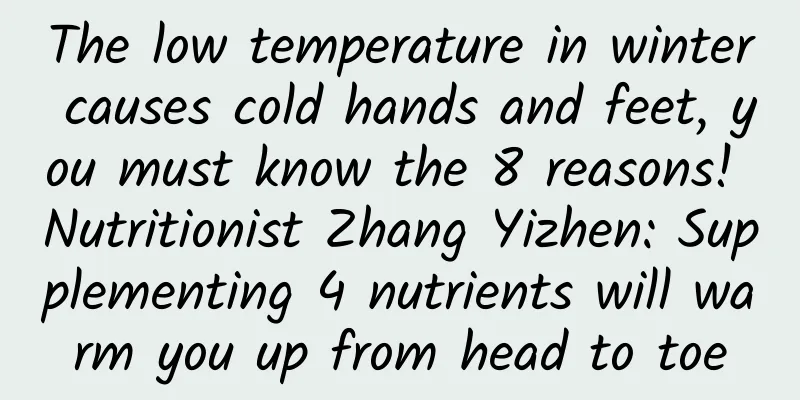The low temperature in winter causes cold hands and feet, you must know the 8 reasons! Nutritionist Zhang Yizhen: Supplementing 4 nutrients will warm you up from head to toe

|
When the temperature drops in winter, many people feel that no matter how many clothes they wear, their hands and feet are still often cold, making them feel freezing. Why are my hands and feet cold? In addition to the impact of low temperature, it may also have a lot to do with the disease itself and blood circulation. In order to combat cold hands and feet, diet should not be neglected. What cold-resistant foods can you supplement to prevent it? Nutritionist Zhang Yizhen recommends 4 major nutrients to keep you warm from head to toe in winter. 8 reasons for cold hands and feetNutritionist Zhang Yizhen said that some people have cold hands and feet even when the weather is not cold. The following are 8 common causes of cold hands and feet: 1. Low temperature: When the temperature drops, our body's protective mechanism will be activated, concentrating blood on important organs to maintain body temperature, and the limbs will therefore receive less heat. 2. Smoking: Nicotine in tobacco products will accelerate arteriosclerosis, make the blood viscous, and cause blood vessels to constrict, thus causing peripheral blood circulation problems. 3. High stress: Tension, anxiety, and high stress will cause the body to release adrenaline. Although the heartbeat will become faster, the blood vessels will constrict, which will cause cold hands and feet. 4. Anemia: The body lacks red blood cells to transport oxygen, resulting in less oxygen received by the limbs, making the limbs easily cold. Since diabetes causes organs to be in a state of high blood sugar for a long time, it can easily lead to mutations in blood vessels and nerves. 5. Hypothyroidism: People with abnormal thyroid function are prone to fatigue, slow metabolism, and cold hands and feet due to affected blood circulation. 6. Cardiovascular disease: High blood lipids or blood clots in the blood vessels can easily cause blood transport obstruction and affect peripheral blood circulation. 7. Diabetes: Diabetes causes organs to be in a state of high blood sugar for a long time, which can easily lead to vascular and nerve mutations. 8. Special diseases: Other diseases related to cold hands and feet include Raynaud's disease, systemic lupus erythematosus, etc. For example, Raynaud's disease will obviously cause the fingers to turn white, or even turn purple due to lack of blood and oxygen. From the above explanation, we can find that cold hands and feet are mainly related to blood circulation. Therefore, improving blood circulation can also solve the problem of cold hands and feet. At the same time, we should also note that cold hands and feet may be a warning sign of cardiovascular disease. It is recommended to go to the hospital for regular health checks to maintain health. Adequate magnesium can help muscles relax, increase blood flow to the limbs, and promote blood circulation. You can eat more nuts and seeds (such as pumpkin seeds, almonds, cashews) in your diet. 👉Recommended reading: When it’s cold, your hands and feet become cold and you get a lot of acne. This may be caused by endocrine disorders! Chinese medicine doctor: Drink this soup to get rid of acne on your face Improve cold hands and feet, supplement 4 nutrientsWhat kind of food should we eat to help improve the problem of cold hands and feet? Nutritionist Zhang Yizhen recommends that you supplement four major nutrients through the following diet: 1. Iron: Iron can help the synthesis of hemoglobin. Adequate iron helps prevent anemia and promotes the transport of oxygen to the limbs. You can eat more pork liver, pig blood, and clams. Vegetarians can supplement iron through red amaranth, black beans, red beans, and dried shredded vegetables. 2. Magnesium: Adequate magnesium can help muscles relax, increase blood flow to the limbs, and promote blood circulation. You can eat more nuts and seeds (such as pumpkin seeds, almonds, cashews) and dark green vegetables. In addition, more than 85% dark chocolate is also rich in magnesium. If you want to supplement it as a snack, you can also consider dark chocolate. 3. Vitamin B group: Vitamin B group maintains many important physiological functions in the body. For example, B1, B2, and B3 (niacin) are related to energy metabolism and can help metabolism. B3 helps vasodilation, and vitamin B12 is related to hematopoiesis. In daily life, you can eat more unrefined whole grains, chicken breast, lean meat, and salmon to supplement vitamin B group. 4. Vitamin E: Vitamin E has an antioxidant effect, can scavenge free radicals, protect vascular endothelial cells to maintain cardiovascular health. Sunflower seeds, peanuts, soybeans, and eggs in the diet are good sources of vitamin E. [Nutritionist's Tips]: Nutritionist Zhang Yizhen reminds that in addition to cold-resistant diet, it is recommended to exercise at least 150 minutes a week, drink 30 ml of water per kilogram of body weight every day, and take measures to keep warm. Drinking some hot ginger tea, wearing gloves, and taking a hot bath can help improve the problem of cold hands and feet. 👉Recommended reading: When a cold wave hits the winter solstice, how to treat cold hands and feet? Warm up your body with a foot bath and drink golden cordyceps and mutton soup to replenish qi and blood VIP Selected Products Latest health knowledge |
Recommend
What are the dangers of premature menopause for women?
Due to the fierce competition in modern society, ...
Haven't you heard of it? Liquid Christmas meal is only 300 calories!
Christmas is here! Christmas parties are full of ...
What are the TCM syndrome differentiation and treatment methods for female cervicitis?
Once a woman suffers from cervicitis, she will be...
What causes threatened miscarriage?
Threatened miscarriage is usually caused by a com...
How to determine if a miscarriage is complete?
To determine whether a spontaneous abortion is co...
Treatment of recurrent miscarriage
Many women may have experienced miscarriage, so w...
The harm of vulvar leukoplakia is related to changes in the internal environment
Since few people really understand the harm of vu...
Why does the right fallopian tube hurt during menstruation?
Why does the right fallopian tube hurt during men...
How to differentiate habitual abortion
How to differentiate habitual miscarriage? Many p...
Endometriosis's harm to women
After medical investigation, it was found that en...
What is the reason for brown discharge during early pregnancy? Here are 3 reasons
If you find brown discharge in the early stages o...
Is it necessary for a girl born without vagina to have an artificial vagina?
With the development of medical technology and pe...
Common clinical symptoms of dysmenorrhea
Dysmenorrhea is a common and frequently occurring...
Is Han Bing and Han Qing's secret to staying slim drinking avocado milk? Nutritionist: Avocado seed water can also help you lose weight
Han Kuo-yu, the mayor of Kaohsiung who has been a...
Sexual dysfunction can cause uterine fibroids in women
Genetics and lack of timely and effective protect...









